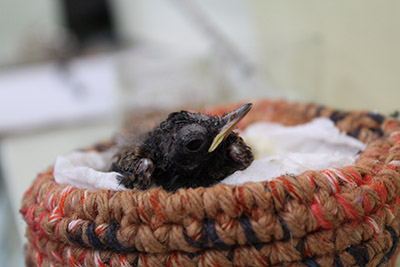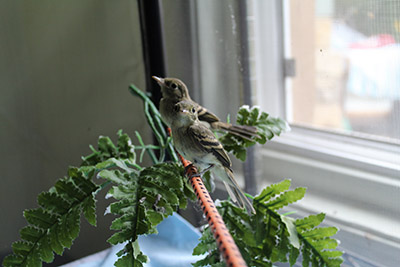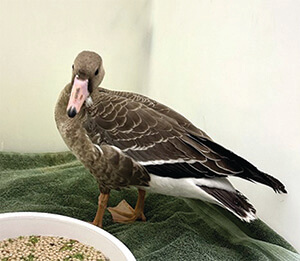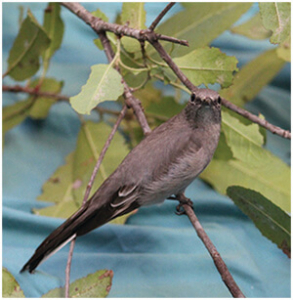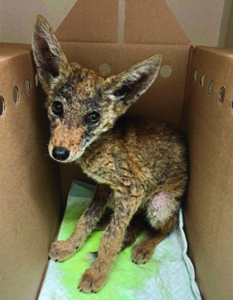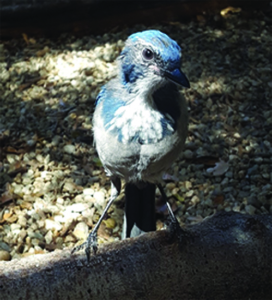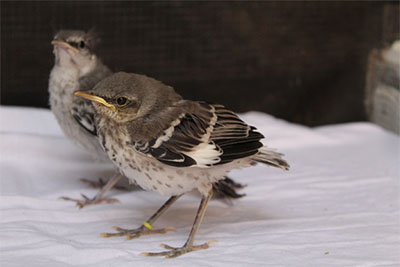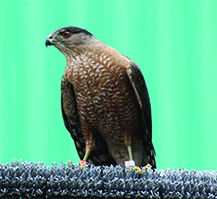By Dr. Guthrum Purdin, DVM
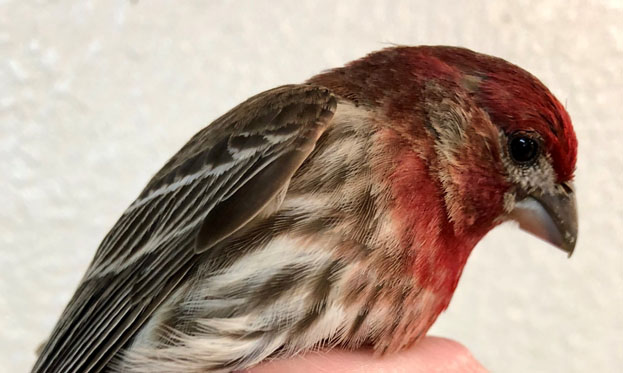
Photo by Dr. Guthrum Purdin, DVM
If you have a birdfeeder in California or have an eye for birds flittering by the side of the trail, you’ve seen House Finches. They’re small, lively, streaky grey birds; only about 21gm (0.74oz) on average. The males’ heads, chests, and shoulders are boldly colored red or reddish orange, looking like they’ve been dipping a little too deeply into somebody’s red wine! Last year, CWC received just over 300 of these little birds that had been rescued by the public, many of them babies still dependent on their parents (or we humans as substitutes…) for care.
Considering this species ranges so widely, from southern Canada, through the United States, and all the way to Central America, living in often harsh environmental conditions, you’d think they would be easy to raise — but you would be mistaken! Baby House Finches (or HOFIs) require very specific food and handling.
Most baby songbirds, regardless of what they eat as adults, are fed an insect diet by their parents. This is done because insects are high in protein — just the thing babies of any species need to grow. Adult HOFIs on the other hand, feed their chicks mostly seeds (including poison oak) and just 2% of the diet is insects. To match these nutritional needs, we mix together the formula diets of two different kinds of birds—those that eat only seeds and those that eat mostly animal protein. It took a lot of experimentation but this mixture provides exactly what HOFI hatchlings, nestlings, and fledglings need.
But that’s not all! Chicks energetically beg food from their parents from sunrise to sunset. Their one job is to eat and grow, and they take that very seriously! As long as it’s light in the room, someone must be ready to feed them. That’s every 30 minutes for hatchlings and every 45 minutes for nestlings and older. When you’ve got racks and racks full of hungry mouths cheeping and waving their yellow beaks & red mouths around, it’s exhausting to keep up. Fortunately, once the lights are out they go right to sleep. As long as they get a good meal before it’s dark, their metabolisms will slow, processing the formula through the night. When morning comes, it’s right back to work for everyone. House Finch parents work hard, and so do our staff and volunteers!
Relying on their parents to decide how much food they should eat, young HOFIs don’t know when they’re full and it’s time to stop begging. So, they beg and gape, gape and beg until their crops can become overfull and stretched out. A ‘crop’ is an out-pocketing of the esophagus at the base of the neck, used to store food between meals in some species. Birds that feed on sporadic food sources in the environment use crops to fill-up between foraging opportunities. But the chicks don’t know when enough is enough, so their crops can become stretched out with food and sit there becoming a petri dish for bacteria, yeast, and protozoal parasites. To deal with this we closely control how much they get at each feeding, checking crops before feeding a nest of hungry mouths. If a bird has slow crop clearance or looks “out of sorts” we take a sample of crop fluid, check it under a microscope, and assign the appropriate medication for whatever organisms may be freeloading in their crops.
So, ‘Don’t Feed Too Much’ is a major rule with HOFIs. Feeding too little is a different problem. If not enough food is given while they are growing, they can become weak and develop poor feathering that may never improve, leaving them flightless or unable to survive the chill of winter.
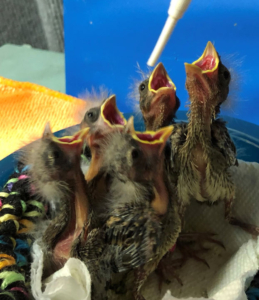
Photo by Dr. Guthrum Purdin, DVM
Hatchlings have no feathers except a few whisps on their heads and are kept warm by their parents until they grow feathers. Consequently, housing is a warm incubator unit for the youngest HOFIs. Once feathered, nestlings are okay for room temperature housing. A fledgling will hop out of the nest, but still can’t quite fly. They want to be away from the nest as soon as they can because nests are at higher risk of predator attacks. Unfortunately, kindhearted people sometimes find these flightless youngsters and think the parents have abandoned them. If you see a cheeping, feathered little grey bird like this, watch it from a distance. Chances are the parent is just out of sight waiting to feed the little one.
At this stage we offer them a tempting selection of chopped greens and seed. Their beaks are still soft, and they aren’t experienced in how to shell seeds, so the greens, like broccoli florets, are the first thing they’ll eat. An adult may shell and swallow a seed in less than a second, while a fledgling may carry a seed around for 20 minutes, practicing handling (beaking?) techniques. In the wild, once fledglings start to fly, they follow their father closely for a few weeks learning what to eat. In human care, as they make the transition to independence, teenage HOFIs have to learn to feed themselves and we are there to support them while they finish growing up.
Only a few short weeks after hatching, they’re self-feeding and ready for the aviary. We raise groups together and after they’ve had some time to exercise and stretch their wings, the whole group will be returned to the wild together — a brand new flock like a busload of teenagers heading off to college.
Dr. Guthrum Purdin, DVM, co-authored the chapters covering House Finches and Blackbirds in the text Hand-Rearing Birds, 2nd Edition, which is an indispensable resource for rehabilitators and other animal care professionals. He also co-edited Topics in Wildlife Medicine Vol. 4: Orthopedics, in which he co-wrote chapters covering fracture repair in songbirds, doves, and hummingbirds.
